Many families struggle to stay in touch, and seniors may feel isolated or abandoned. This can be devastating for people with Alzheimer’s or dementia who aren’t able to use popular video calling apps and may not understand the situation. Let's examine this issue and discuss some available solutions.

Michael Cottam cares for his father-in-law, who has dementia and lives in a nursing home. He struggled with staying in touch. Then he figured out how to make video calls without his father-in-law having to press buttons or ask staff for help each time. Here, he shares a solution everyone can use and sets up mistakes to avoid.
Isolation has Been Devastating For People with Alzheimer’s and Dementia
Modern times have made it challenging to keep in touch with someone who lives in a nursing home or assisted living community.
At times, long-term care facilities go into “lockdown” to reduce exposure to community illnesses. Family and friends cannot visit in person – only staff can enter the building.
To make matters worse, group activities and dining room meals in many care communities have been suspended to keep residents physically distanced and reduce the spread of the virus.
This level of isolation and the significant changes in daily routine have been especially devastating for people with Alzheimer’s, dementia, and other cognitive impairments.
Accustomed to regular family visits and not being able to comprehend what a global pandemic is, someone with dementia doesn’t understand why they’re suddenly alone and often feels abandoned.
Sure, there are plenty of video-calling apps and devices, but these modern apps can be confusing and overwhelming for many older people.
And if they have memory issues, it’s even more challenging – you can teach them how to use the device on Tuesday, and by Thursday, they’ve forgotten everything you taught them.
How I Regained Our Connection With My Father-In-Law
When the pandemic started, my family was cut off from my father-in-law, who has dementia and lives in a memory care community.
The care staff was busy with added tasks and couldn’t spend much time helping residents connect with their families.
Without their help, it’s nearly impossible for families to stay connected because someone with more advanced dementia isn’t able to initiate or accept video calls, no matter how simple the technology.
Even without memory issues, most people in nursing homes aren’t comfortable with new technologies like smartphones, touchscreens, and voice-recognition devices.
When we were able to get in touch with my father-in-law, we were shocked and saddened to see how quickly he had declined in such a short time.
He reached the point where he couldn’t figure out how to answer his Android phone when it rang – let alone make a call himself. And then he’d forget to plug it in to recharge it, so when we’d call, we’d always get his voicemail.
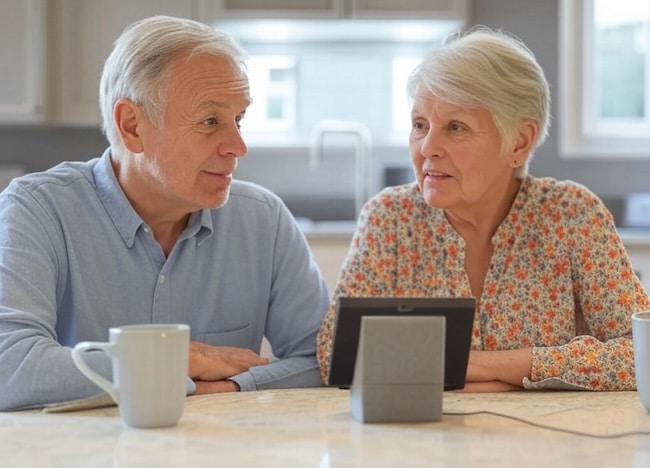
So, I figured out how to put a video calling system in place that would let us see and talk with him – without any action needed on his part.
We’d call, he’d hear our voices, turn towards the sound (he’d forget he had the device in the room until then), see our faces, and all he had to do was smile and say hello.
After we began video chatting with him regularly, my father-in-law improved significantly.
Interestingly, we found conversations with him went much better when we could see each other’s faces – often, plain old phone calls would, for some reason, turn adversarial.
To help others in similar situations, I found three devices that let you video chat with someone who can’t answer a call. They use a feature called “drop-in” calling.
Another plus to using these devices is that they’re always plugged in – the person doesn’t have to remember to recharge them.
My father-in-law would sometimes realize his smartphone needed to be plugged in, and we’d find him trying things like his electric razor cord, or plugging one end of a USB cable and pulling the other out of the USB charging brick.
All those problems go away with a permanently-plugged-in device next to his TV.
I also share tips that helped me set up our Echo device and “drop-in” calling feature ahead of time (so I needed minimal help from the nursing home staff), what to do if their WiFi connection is too weak, and a resource for financial assistance.
“Drop-in” Calling Lets You Make Video Calls to Someone Who Can’t Answer
“Drop-in” calling means the device answers your call with no action required on the part of the person receiving it.
It can be an essential feature if the person in the nursing home has forgotten how to answer the phone.
If the device has a drop-in calling feature, please place it in the room where they usually read or watch TV. Then, when you call, you appear on the screen; they hear your voice, turn and see you, and off you go.
The other advantage of drop-in calling is that it doesn’t require an ancient set of fingers to operate a touchscreen.
My father-in-law’s hands are dehydrated and wrinkled. I’ve watched him try to swipe to answer his smartphone a half dozen times, and the screen didn’t recognize the touch like it would for a younger pair of hands.
3 Video Call Devices with “Drop In” Calling
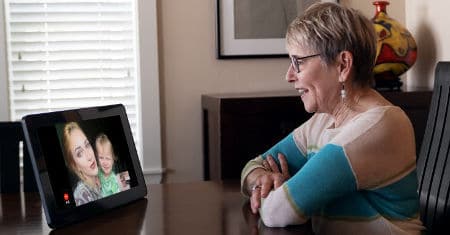
ViewClix Smart Frame – 10-inch screen ($200) & 15-inch screen ($300)
This smart picture frame displays digital photos and supports video calling with an auto-answer mode.
When choosing a screen size, consider your family member’s vision: is it poor, or starting to go? If so, go with a bigger screen.
When auto-answer is set up, the older adult doesn’t need to do anything to receive a video call.
There’s no power switch, so the device is always on. It displays photos and is always ready for video chatting or to show newly added images.
You’ll set up a secure Share List with the names and email addresses of people authorized to share pictures and make video calls.
You sure don’t want solicitors (or people they might have a rocky relationship with) to be able to parachute into their room at any time of the day or night!
You can also remotely manage the device from any web browser and set features such as whether the frame auto-answers video calls, how long each Slideshow picture is displayed, and whether the ViewClix Smart Frame goes to “sleep” during late-night hours.
Watch a 30 second video to see how the ViewClix Smart Frame works
See ViewClix Smart Frame customer reviews
Note: ViewClix Smart Frames are more expensive (Echo devices are often discounted from the list prices shown below), but as you’ll see below, the Echo setup process is more complicated.
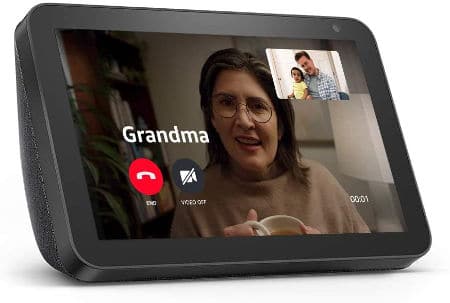
Amazon Echo Show
The Echo Show is an Alexa personal assistant (like an Echo or Echo Dot) with a video screen.
To make video calls without your older adult needing to accept the call, use the Echo Show’s “drop in” feature.
This feature allows you (or other preselected relatives or friends) to start a video call and automatically appear on the Show’s screen and be able to speak with and hear your older adult – they just need to be in earshot and don’t need to do anything.
“Drop-in” calls can be made between two Echo devices, and you can also initiate a “drop-in” call using the free Amazon Alexa app from your smartphone.
Currently, there are 3 of these types of devices available (prices frequently discounted):
- $90 Echo Show 5 – 5.5” screen
- $130 Echo Show 8 – 8″ HD screen and stereo sound, many customer reviews say this is the best of the three Show options
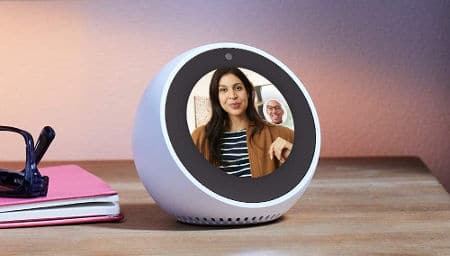
$130 Amazon Echo Spot (price frequently discounted)
The Echo Spot has a small screen, but it has the same video calling and drop-in features as the Echo Show.
This would have worked just as well for my father-in-law, who doesn’t have any vision issues at this point, but screen size might make a difference for your family member.
How to Set Up the “Drop In” Feature on an Amazon Echo Device
We decided to get my father-in-law an Echo Show, and while it was a bit complicated to get it set up (learn from my mistakes below), once it was up and running, it’s been smooth sailing.
This Digital Trends article walks through how to set up the drop-in feature on an Echo device.
This HelloTech article also includes instructions and screenshots for setting up the Alexa app to make drop-in calls.
This article from the AT3 Center includes a video demo of the drop-in feature (scroll to the middle of the page) so you can see how it works.
If you need help getting the Echo set up, chat online or speak with an Amazon representative over the phone.
To reach an Amazon representative by phone, visit their Contact Us page, select the smaller “We can call you” link beneath the big “Start chatting now” button, and provide the necessary details to connect with someone who can help.
How to Connect a Device to the Internet in a Nursing Home
To ensure you can communicate with the device and minimize the time and effort required of care community staff, do as much setup as possible ahead of time.
That’s why you’ll need to have the device shipped to your own house first.
You can remove all the excess packaging, plug it in, and set it up to connect to your own home WiFi network.
Then, set up any apps or devices you’ll need on your side.
Get familiar with the settings, and maybe take a few photos of the screens with your smartphone. That way, if the person in the nursing home helping with the setup has any questions, you’ll know what they’re looking at and can answer.
Remember, when you deliver the device to the nursing home, they’ll take it inside (where you can’t go), wipe it down, and then you’ll probably have to walk them through the setup from the other side of a door or on the phone.
You won’t be able to stand beside them and set it up yourself.
Most likely, the help you’ll need from a care community staff member is for them to:
- Place the device in a good spot in your older adult’s room, preferably near where they usually spend their time (and where you can easily see each other), and plug the power cord into a wall outlet without creating a tripping hazard.
- Change the Wi-Fi network name and password to match the care community's.
- Use your family member’s mobile phone to get and enter the verification code.
To make things easier for a staff member, write down the necessary steps and include your phone number so they can call you if they need help, and let you know when it’s all set up.
You might even want to tape your name and phone number to the back of the device so a staff member can quickly contact you if there’s a problem.
VERY IMPORTANT: Never use your own phone number for their Echo device
Don’t set their Echo up with your mobile phone number initially to test it! Switching it to your family member’s mobile number is excruciatingly tricky (but necessary).
Because my father-in-law couldn’t reliably answer his mobile phone (and never managed to figure out how to read a text message), we had to ask a staff member at the care home to go to his room and use his phone for him during setup.
That included entering his mobile phone number into the Echo device, sending a verification code to his phone, and entering it back into the Echo device.
If they don’t have a mobile phone, or if you want to set up and test the whole system ahead of time
Some seniors in nursing homes may not own a mobile phone. If that’s the case, you don’t necessarily need to buy one to use the Echo device.
But you can’t just use your own mobile phone number – that’s where I got into trouble.
At first, I set up the Echo with my own mobile phone number, thinking I could test it and change it later.
Then, I installed the Amazon Alexa app on my mobile phone. When I tried to call the Echo device through the Alexa app, it seemed lost, and I didn't know which device to talk to. Maybe the Echo felt like it was calling itself and got confused.
I haven’t tried this option, but based on my experience, you can pair the Echo with any mobile phone (as long as it can receive text messages). You can't use that specific phone to call the Echo.
So if your older adult doesn’t have a mobile phone or wants to set everything up ahead of time, you could use someone else’s mobile number for the setup process, as long as that person will never video call your older adult’s Echo using that mobile phone number.
In case you’re interested, here’s our family’s current setup:
My Apple iPhone
- Mobile number 503-349-xxxx
- Alexa app installed from the Apple App Store
Father-in-law's Echo Show
- Mobile number 541-xxx-xxxx (his actual mobile phone number)
- Alexa is built-in
Father-in-law's Android mobile phone
- Mobile number 541-xxx-xxxx (same as used for the Echo Show)
- NO ALEXA APP INSTALLED HERE
My sister-in-law's Android phone
- Mobile number 360-xxx-xxx
- Alexa app installed from Google Play
What to Do if the Nursing Home WiFi Connection is Weak
If the internet connection is slow or too many people are using a care community’s WiFi, video chats can get choppy or cut off completely.
If this is a frequent problem, but cellular signals are strong at their location, you might consider getting a WiFi hotspot to place in your older adult’s room.
Major cell phone carriers like AT&T, Verizon, T-Mobile, Mint Mobile, and others sell mobile hotspot devices and service plans, or let you use a smartphone as a hotspot.
AT3 Center shares tips for turning an old smartphone into an internet hotspot. Be sure to check with your carrier to confirm this will work.
Generally, you’ll need to:
- Add a line to your mobile phone plan, then plug the smartphone in to keep it powered.
- Check the smartphone’s user guide to find out how to activate the “personal hotspot” option.
- Change the device’s WiFi network name and password to the hotspot.
Financial Assistance for Video Calling Devices
If paying for a device is a challenge, contact your State AT Program (from the National Assistive Technology Act Technical Assistance and Training (AT3) Center) to learn about funding options available in your state.
If you want to try it out, ask if your State AT Program has an Echo Show to borrow from their short-term device loan program.
Equipment loans are a great way to see if the device can work for you and your older adult. Some programs may also offer virtual demonstrations.
Recommended for you:
- Amazon Echo Alexa for Seniors with Dementia
- Nursing Home Lockdown: 6 Ways to Stay Connected with Seniors During a Coronavirus Scare
- 8 Mental Health Tips for Caregivers During Coronavirus
- 8 Shelter-in-Place Coronavirus Tips for Senior Care in Your Home
Guest contributor: Michael Cottam is an industry-leading expert in Search Engine Optimization (SEO). He’s an Associate at Moz, presents at top industry events, partners with top firms on high-profile projects, and was previously a board member of SEMpdx. He’s an avid traveler, a scuba diver, and a father. He cared for his father-in-law with dementia for several years.











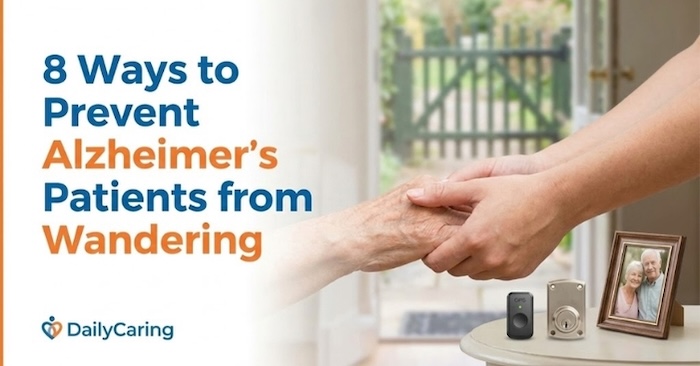

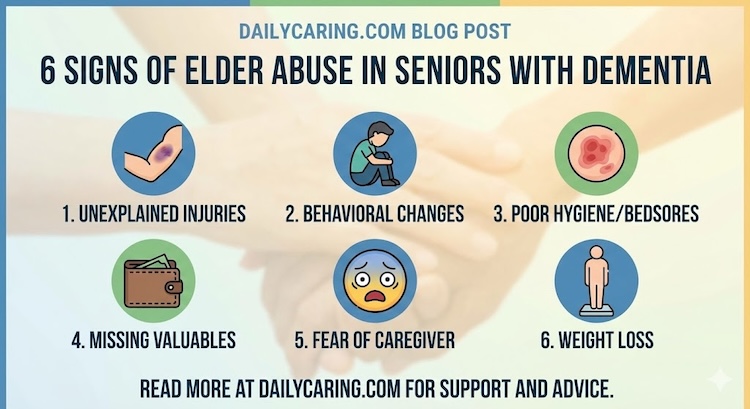
My mother is very hard of hearing and even with the hearing aids she struggles. Echo Show has closed captioning, which has helped her a lot. However, the CC feature mysteriously disappears. It takes a very long factory rest to bring it back. It stays on for a few calls and then it is gone again. Are there any other devices like this that provide the CC feature? I haven’t been able to find any.
Reading this article because we’ve just been told today by our Mother’s nursing home that under current Public Health England guidelines, as of (2nd March 2022), it’s not going to be possible to take her out to a local tearoom which has been booked out exclusively for our twelve family members for a small party to celebrate her 100th Birthday. The nursing home community of circa 45 residents and 15 staff are still classed as an ‘Outbreak zone’ due to one positive test out of 59 negative tests. The one positive test is a resident on a different floor who doesn’t have contact with our Mum. This was their status after everyone was tested on Friday and results collated on Sunday. So currently ensuring that this directive is correct and absolutely in line with official Government guidance as so often questions and answers can be misinterpreted along the way.
However as a contingency we’re now urgently looking to install a two way video solution so Mum can take part in a video within the nursing home and her 12 family and friends can similarly celebrate her Birthday all assembled within the tearoom.
This article contains some great information and I’m hoping we can install something viable using this information within. what is now this very short timescale in readiness for Friday 4th March 22. Here’s hoping.
We’re so sorry to hear of this sudden policy change by the nursing home. That must be such a disappointment to your mother and the whole family. Unfortunately, the Covid chain of transmission can be tough to pin down, so the nursing home must follow the government guidelines to ensure the safety of their residents and staff.
We hope that the above article helps you get a two-way video chat device installed in time to celebrate her birthday. You might also contact a retail store specializing in electronics and other technology (TVs, computers, etc.) near you to see if they have programs that can help. We’re based in the U.S. so we’re not familiar with British stores, but in the U.S. a chain like Best Buy would be a helpful resource. Hopefully, there are similar stores near you.
We wish your mother a very happy birthday!
I bought a viewclix for my mother but the facility says we cannot use anything where the camera is on 24/7 and they said if their wi/fi goes down they will get it fixed as their schedule permits they told us we are more than welcome to hook up mom with an internet service with AT&T
Unfortunately, regulations and availability of WiFi are different in each care community. We don’t have direct experience with the ViewClix, but perhaps there’s an easy way to turn the camera on and off so you can still video chat with your mother. And hopefully her facility’s WiFi won’t have many problems.
I was able to set u my mother’s dot by standing just outside the building and using their WIFI. I powered it with a USB battery supply. Staff was grateful that all they needed to do was to plug it in.
That’s a fantastic way to get it set up! Thanks for sharing this great tip.
We went with the Grand Pad from Consumer Cellular, since my aunt did not want a cell phone (she was afraid she’d misplace it) and the Nursing Home only had 4 dedicated cell lines for the patients. That was why we didn’t go with the Echo. It would have been the same problem of calling the Nursing home directly and having someone run to her room with one of the four cell phones. With the GrandPad, we input the numbers of those that we knew she wanted to hear from, and added their pictures. Because her eyesight is limited, we were more concerned that she would be answering unknown numbers. This system seems to be more limiting in who can call in, but she can also ask one of the aides to help her find the number of the person she wishes to speak to by scrolling passed the names included. It’s working so far.
That’s wonderful! So glad you found something that works well for your aunt and helps her stay in touch.
Hi, I was told that the Echo 5 video was a violation Fl the hippa law.
The nursing home my mother is in will not allow her to have it.
Any suggestions?
Unfortunately, every state and each care community has different rules and regulations around the use of video or recording devices. You may want to speak with them about what other devices or solutions are allowed under their policies.
Thank you for this info. As hard as we’ve tried to keep my mom… 92 years old at home with us, I fear the day is coming soon when I’ll no longer be able to care for her since I have no family support. As concerned as I am about committing her to a care center with the Covid -19 virus still raging on in the nursing home my second concern was not being able for her to see us. Your article is priceless. She does suffer from dementia as well. My heart breaks for all the families snd their loved ones during this time of isolation. Thank you for providing an answer. God bless you, God bless us. God bless America.
We’re so glad this information is helpful! It’s so hard and heartbreaking when family isn’t able to stay connected when someone is living in a care community and can’t have visitors due to the pandemic.
But that may be the best place for them to get the care they need. Caring for someone at home isn’t always possible, especially as their care needs increase and if you don’t have the help you need to keep both them and you safe and healthy.
We wish you all the best as you navigate this challenging situation.
Wondering if the smaller screen is adequate in terms of resolution. The larger screen isn’t necessary for viewing size but I see it has better resolution.
That’s a great question, but unfortunately there’s no straightforward answer. Everyone has a different idea of what’s good enough when it comes to how a screen looks.